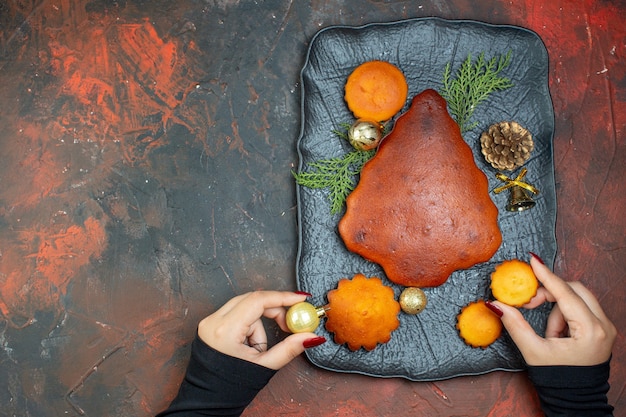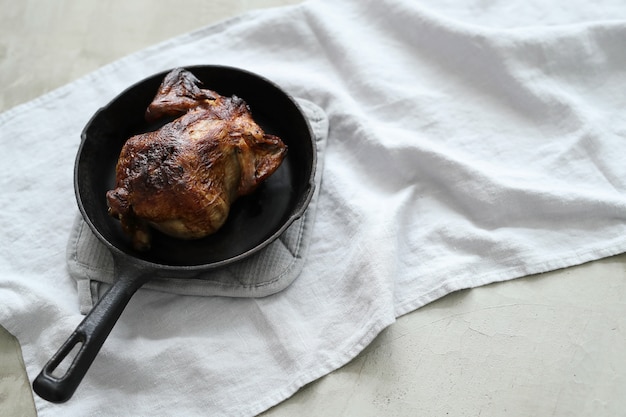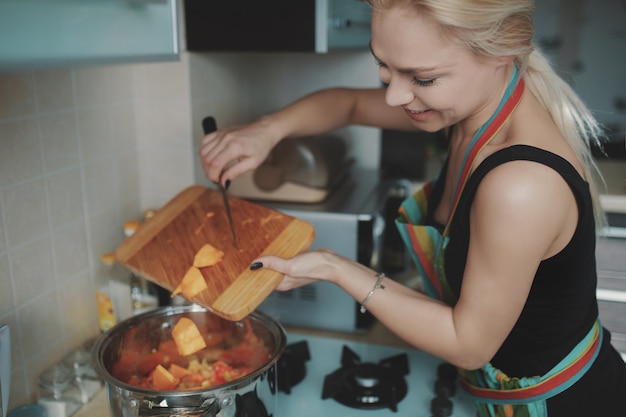Ah, chicken thighs. They’re the unsung heroes of the kitchen, offering up juicy, flavorful goodness that makes any meal feel special. And let’s face it, they're way more forgiving than those finicky chicken breasts. But even with their forgiving nature, I’ve had my fair share of dry, rubbery chicken thighs in the past. Those days are long gone, though! After years of experimentation and a few burnt offerings (my smoke alarm is my best friend, honestly), I've finally cracked the code for perfectly cooked stovetop chicken thighs.
In this article, I'll walk you through the entire process, from choosing the right chicken to achieving that delicious sear, all the way to creating a flavor-packed pan sauce. We'll cover everything you need to know to turn those chicken thighs into a culinary masterpiece, even if you're a kitchen newbie. Ready to ditch those dry, overcooked chicken woes? Let's dive in!
(Part 1) Picking the perfect chicken Thighs

Bone-in or Boneless: A Question of Flavor and Tenderness
Let's talk chicken thighs themselves, shall we? I'm a firm believer in the power of bone-in, skin-on chicken thighs. They just seem to hold their moisture better, and the skin gets all crispy and delicious. The bone, in my opinion, adds an extra layer of flavor that you just can't get with boneless thighs. It also helps to keep the meat tender and juicy. Plus, if you're looking for a more rustic feel, the bone adds a bit of charm to the dish.
However, I totally get it if you prefer boneless, skinless chicken thighs. They're easier to cook and handle, and they're perfect for quick and easy weeknight meals. They also tend to cook a bit faster than bone-in thighs, making them a good choice for busy evenings.
Skin-on: A Delicious, Crispy Barrier
Now, let’s chat about skin. I’m a big fan of skin-on chicken thighs. Not only does it add a bit of extra fat (which, believe me, is a good thing when it comes to flavor and moisture), but it also creates a wonderful crispy barrier that locks in all the deliciousness. It gets all golden brown and crispy, offering up a delightful textural contrast.
Of course, if you're watching your fat intake, you can always remove the skin. Just be sure to pat the thighs dry with paper towels to ensure even cooking and a little extra crispiness.
The Right Size Matters
When it comes to the size of your chicken thighs, I usually go for 4-6 ounces each. That's a good size for a single serving, and they cook up nicely in a skillet. But, you can definitely adjust the recipe depending on how many people you're feeding. Just make sure you're using a pan that can comfortably accommodate the chicken without overcrowding.
(Part 2) Setting the Stage for Success

The Right Tools for the Job
You'll want to start with a good quality, heavy-bottomed skillet. Cast iron is always a winner, but any good quality non-stick pan will do. Heavy-bottomed pans distribute heat evenly, which helps to prevent your chicken from sticking to the pan. A good skillet is a key to achieving that beautiful, even sear.
The Importance of Heat
Next up, heat. You'll need medium-high heat to get a nice sear on your chicken. The key is to make sure the heat is high enough to get the skin crispy, but not so high that it burns the chicken before it has a chance to cook through. If your pan isn't getting hot enough, you'll end up with soft, mushy chicken, and no one wants that.
Don’t Shy Away from Fat
You know how everyone says fat is bad? Well, in the case of chicken thighs, fat is your friend. It’s what makes them juicy and flavorful. Don't worry about the excess fat; you can always drain off any extra after cooking. The pan will do most of the work for you, and trust me, the flavor is worth it. Just make sure you're using a pan that can handle a bit of fat, and don’t be afraid to add a little extra butter or oil to the pan for good measure.
(Part 3) Mastering the Art of Searing

Searing is essential for cooking perfect chicken thighs. It gives the chicken that beautiful golden brown crust and intensifies the flavor.
Getting That crispy skin
First things first, make sure those chicken thighs are completely dry. We're going for crispy, not steamed. Place the chicken in your hot skillet, skin-side down. Don't overcrowd the pan, or the chicken will steam instead of sear. Let it cook undisturbed for about 5-7 minutes, or until the skin is golden brown and deliciously crispy. Resist the urge to move it around too much during this time; you want that skin to get that nice, caramelized crust.
If you're using bone-in chicken thighs, you might notice that the bone starts to pull away from the meat. This is a good sign that the chicken is cooking evenly.
Flipping for Even Cooking
Once the skin is nicely seared, flip the chicken thighs over and sear the other side for about 3-5 minutes. You want to make sure the chicken is cooked through on both sides.
Don’t Forget the Edges
Finally, don't forget about the edges! Take a minute to sear the edges of the chicken thighs after you've seared both sides. This helps ensure that the chicken is cooked evenly throughout.
(Part 4) The Key to Juicy, tender chicken
Now, you have a choice: finish cooking those thighs on the stovetop or transfer them to the oven. Personally, I think finishing them in the oven results in the juiciest, most tender chicken, but both methods work.
Low and Slow for Tenderness
If you're finishing the chicken on the stovetop, reduce the heat to low, cover the pan with a lid, and let it cook through. This will create a moist environment and prevent the chicken from drying out.
For the oven method, preheat your oven to 350°F (175°C). Transfer your seared chicken thighs to a baking sheet and bake for 15-20 minutes, or until the internal temperature reaches 165°F (74°C).
Checking for Doneness
Using a meat thermometer is the most reliable way to check for doneness. The internal temperature of cooked chicken should reach 165°F (74°C). This ensures that the chicken is safe to eat and cooked through.
If you don't have a meat thermometer, you can check for doneness by pressing on the chicken. Cooked chicken should be firm to the touch, and the juices should run clear. If the juices are still pink, the chicken needs more time in the oven.
(Part 5) Adding Flavor to Your Chicken
Chicken thighs are a blank canvas waiting for your culinary creativity. But don't be shy with the seasoning! Chicken thighs can handle a lot of flavor and will only taste better for it.
The Essential Seasoning Trio
My go-to seasoning for chicken thighs is a simple trio: salt, pepper, and a sprinkle of paprika. But, you can get really creative here. Experiment with different herbs and spices like garlic powder, onion powder, thyme, rosemary, oregano, or even a pinch of cayenne pepper for a little kick.
Another tip: add a little bit of butter or olive oil to the pan during searing. It adds richness and enhances the flavor.
Marinades for Maximum Flavor
For an extra burst of flavor, try marinating your chicken thighs beforehand. There are endless possibilities for marinades: a simple lemon juice, olive oil, and herb mix, or something a bit more complex with soy sauce, honey, and ginger.
The key is to marinate the chicken for at least 30 minutes, or even overnight for maximum flavor infusion.
Don’t Forget the Pan Sauce
Pan sauces are the perfect way to elevate your chicken thigh dish. They’re incredibly easy to make and add a depth of flavor that will have everyone asking for seconds.
To make a pan sauce, simply deglaze the pan with a bit of wine, broth, or water. Scrape up all the browned bits from the bottom of the pan; those little bits are packed with flavor. Then, simmer the sauce until it thickens slightly. You can add herbs, spices, or even a dollop of cream to customize your sauce.
(Part 6) A Few More Tips
Rest for Juiciness
Once those chicken thighs are cooked to perfection, let them rest for about 5-10 minutes before slicing and serving. This allows the juices to redistribute throughout the meat, making for a juicier, more tender chicken.
Serving Suggestions
Chicken thighs are incredibly versatile. They pair well with so many side dishes: roasted vegetables, creamy mashed potatoes, couscous, quinoa, rice, or a simple green salad.
Leftovers? No Problem!
Leftover chicken thighs are a culinary treasure. They can be used in sandwiches, salads, or even just reheated and served with your favorite sides. They’re a great way to make a quick and easy meal out of leftovers.
(Part 7) Don't Be Afraid to Experiment
This guide is just a starting point. The best way to learn how to cook chicken thighs is to experiment and find what works best for you. Don't be afraid to try different cooking techniques, seasoning combinations, and side dishes.
Remember, there's no right or wrong way to cook. It's all about finding what you enjoy and what works best for you. So go ahead, get creative, and enjoy the journey of becoming a chicken thigh master!
(Part 8) FAQs:
Q1: Can I cook chicken thighs in a smaller pan?
Yes, you can use a smaller pan, but make sure it's big enough to hold all the chicken thighs without overcrowding. This will ensure even cooking and prevent the chicken from steaming.
Q2: How long should I cook chicken thighs on the stovetop before transferring to the oven?
You should sear the chicken thighs for about 5-7 minutes per side on the stovetop, then transfer them to the oven to finish cooking. This ensures that the chicken is cooked through and has a nice, crispy crust.
Q3: Can I add vegetables to the pan while cooking the chicken?
Yes, you can! Just be sure to add them after you've seared the chicken so they don't steam instead of getting nice and crispy. Root vegetables like potatoes and carrots can be added towards the end of the cooking time, while delicate vegetables like green beans or asparagus are best added during the last few minutes of cooking.
Q4: What happens if I overcook my chicken thighs?
If you overcook chicken thighs, they will become dry and tough. To prevent this, make sure to check the internal temperature of the chicken using a meat thermometer. The chicken is done when it reaches 165°F (74°C).
Q5: Can I use frozen chicken thighs instead of fresh?
Yes, you can use frozen chicken thighs, just make sure to thaw them completely before cooking. You can thaw them in the refrigerator overnight or in a cold water bath for a couple of hours.
(Part 9) A Table for Easy Reference
Here's a handy table summarizing the cooking times for chicken thighs:
| Chicken Thigh Type | Cooking Time (Stovetop) | Cooking Time (Oven) |
|---|---|---|
| Bone-in, Skin-on | 10-12 minutes per side | 15-20 minutes at 350°F (175°C) |
| Bone-in, Skinless | 8-10 minutes per side | 12-15 minutes at 350°F (175°C) |
| Boneless, Skin-on | 6-8 minutes per side | 10-12 minutes at 350°F (175°C) |
| Boneless, Skinless | 4-6 minutes per side | 8-10 minutes at 350°F (175°C) |
Remember, these are just general guidelines. The actual cooking time will depend on the size of your chicken thighs, the thickness of the meat, and the heat of your stovetop or oven.
(Part 10) Conclusion
So there you have it! Your complete guide to cooking perfect chicken thighs on the stovetop. Remember, it's all about understanding the basics, being patient, and having fun in the kitchen. Don't be afraid to experiment, adjust the recipe to your liking, and let those delicious chicken thighs shine! Happy cooking!
Everyone is watching

Corn on the Cob: The Ultimate Guide to Perfectly Cooked Ears
Healthy MealsAh, corn on the cob. Just the name evokes images of sunny days, barbecues, and that sweet, juicy flavour that ...

Perfect Pork Roast Oven Cooking Time: A Guide to Delicious Results
Healthy MealsThere's something truly satisfying about a perfectly roasted pork. The aroma alone is enough to make your mout...

Ham Cooking Time: How Long to Bake, Smoke, or Boil a Delicious Ham
Healthy MealsAh, ham. It's a classic, isn't it? A real crowd-pleaser, especially around holidays. And when done right, it'...

Scallops: The Ultimate Guide to Perfect Cooking
Healthy MealsAh, scallops. Those delicate, sweet, and utterly delicious morsels of the sea. They hold a special place in my...

Spaghetti Squash: The Ultimate Guide to Cooking and Serving
Healthy MealsRemember that time you saw spaghetti squash at the supermarket, looking all bumpy and strange, and thought, "W...
